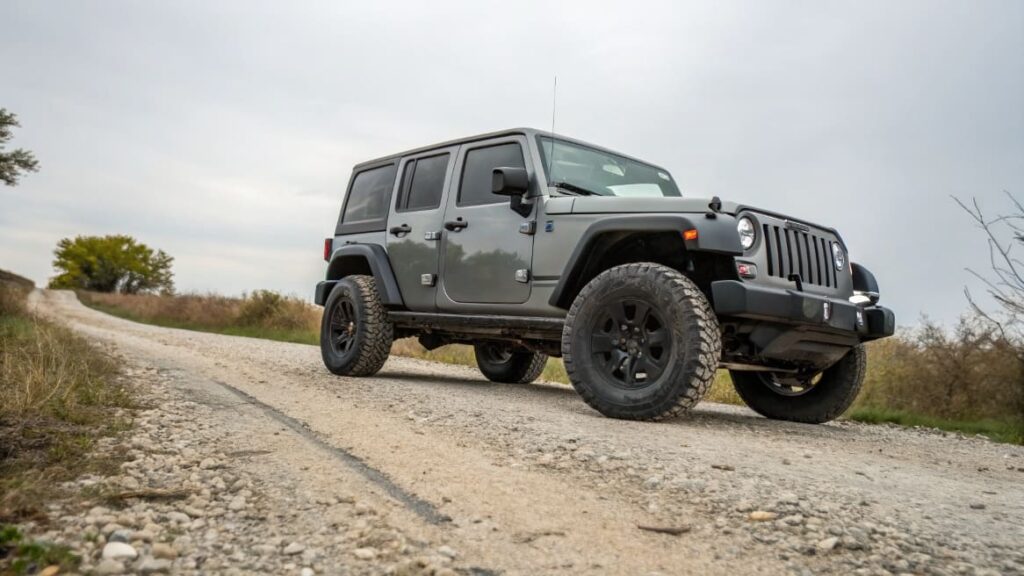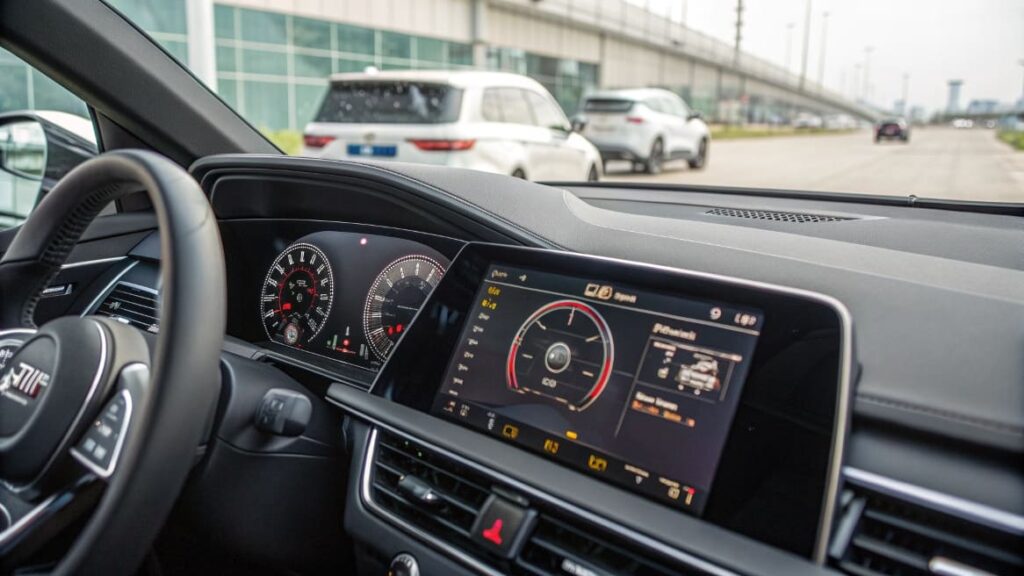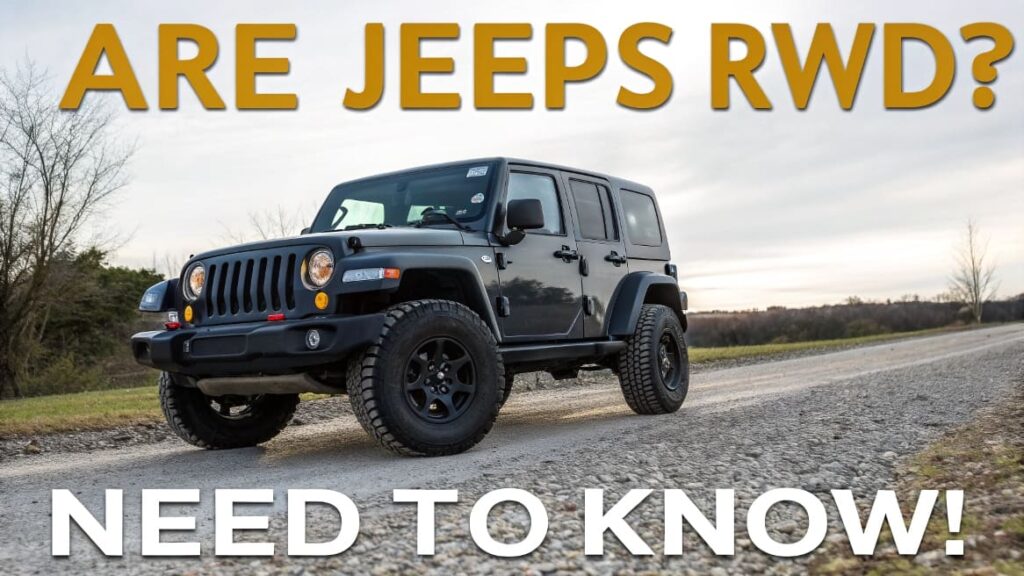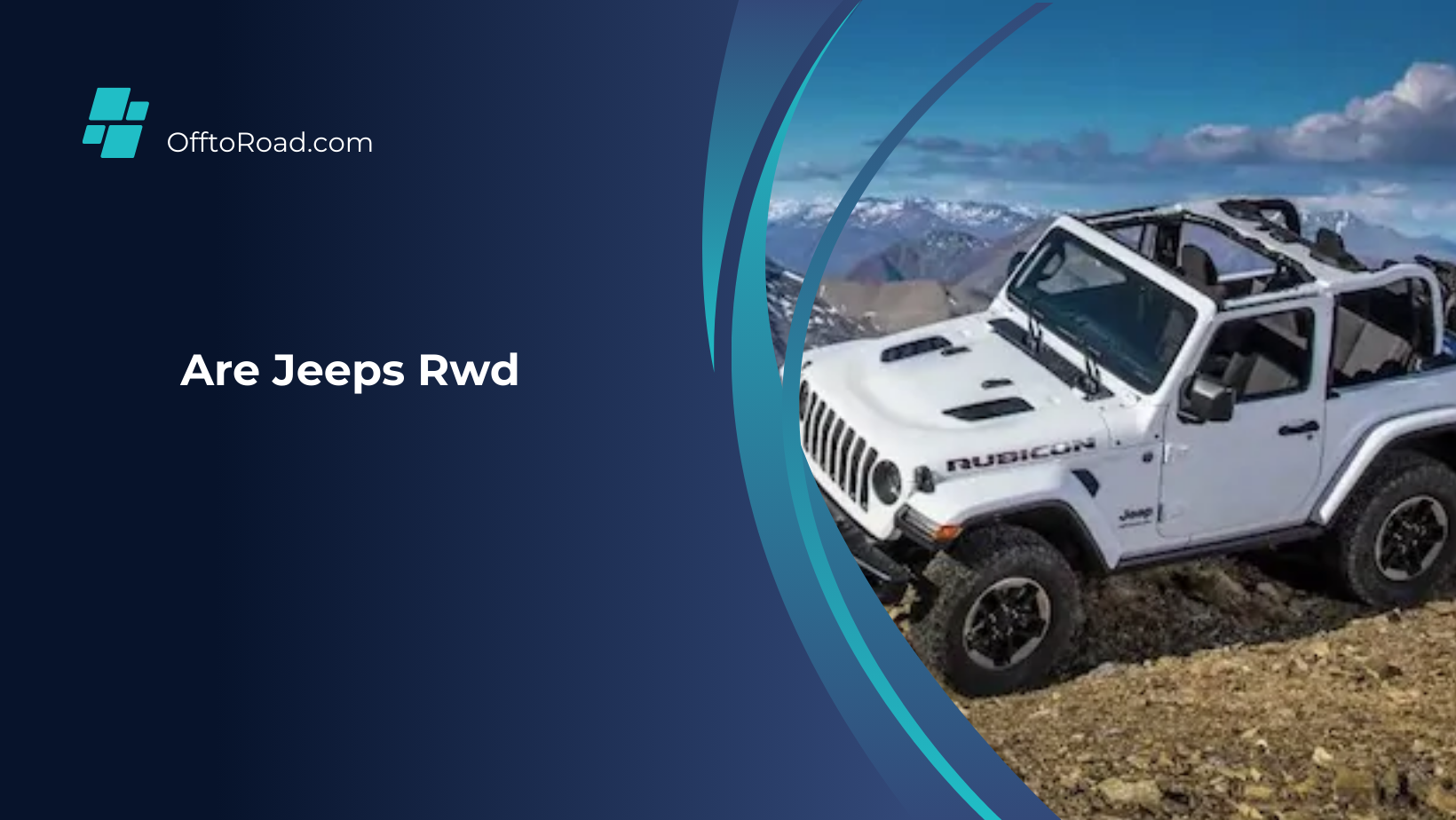When I bought my first Jeep Grand Cherokee, I didn’t even realize it was rear-wheel drive until I hit a slick road in winter—lesson learned! It drove great in dry weather, but I ended up switching to a 4WD model later for better traction. For me, RWD was fine in the city, but not the best for snowy roads.
Yes! Some Jeep models are rear-wheel drive (RWD), especially base trims like the Grand Cherokee and Wagoneer. However, off-road-focused models like the Wrangler and Gladiator come standard with 4WD. So, whether a Jeep is RWD depends on the model and trim level.
Stay tuned with us as we dive into the world of Jeeps and answer the big question: Are Jeeps RWD? Whether you’re a city driver or an off-road adventurer, we’ve got the details you need. Don’t miss out—more insights coming your way!
Are all Jeep Wranglers 4 wheel drive?
Yes, all Jeep Wranglers come with 4-wheel drive (4WD) as standard. This feature is what truly makes the Wrangler stand out, especially if you’re into off-roading or tackling tough terrains. Whether you choose a base model or a higher trim, you’ll find that 4WD is built into every single Wrangler.

It’s designed to give you that extra bit of control when you’re navigating rough roads or heading off the beaten path. Simply put, the Wrangler’s 4WD system is there to make your adventure as smooth and capable as possible.
Why do 4×4 vehicles like the Jeep Wrangler have a speed limit in 4WD mode, while full-time AWD vehicles don’t?
Why 4×4 vehicles like the Jeep Wrangler have a speed limit in 4WD:
- In 4WD mode, the front and back wheels are locked together.
- This means all the wheels spin at the same speed.
- That’s great for off-road or slippery roads, but not for dry pavement.
- On normal roads, the wheels need to spin a bit differently, especially when turning.
- If they can’t, it puts a lot of stress on the parts inside (like the transfer case).
- To avoid damage, the manual says to stay under 80 kph in 4WD.
Why AWD vehicles don’t have this limit:

- AWD systems automatically send power to all wheels.
- The wheels can still spin at different speeds when needed.
- This helps avoid stress and keeps things running smoothly.
- AWD is made for all kinds of roads, even at higher speeds.
- So, 4WD is strong for tough roads, but needs limits. AWD is smoother and better for everyday driving.
What is the safest way to put a Jeep Wrangler in 4 wheel drive?
To safely engage 4WD in your Jeep Wrangler, the first step is to slow down. It’s a good idea to reduce your speed to under 55 km/h (about 35 mph), especially if you’re on dry pavement. This simple step helps avoid strain on your drivetrain and makes the transition to 4WD a lot smoother.
Next, shift into Neutral. If your Wrangler has a manual transfer case, it’s important to do this before engaging 4WD. Shifting to Neutral lets the transfer case engage properly without any stress.
Once you’re in Neutral, it’s time to engage the 4WD system. Depending on your model, you’ll either move the transfer case lever or turn a dial to select the 4WD setting. For regular rough roads or slippery conditions, 4WD High is perfect. But if you’re heading into more challenging off-road terrain, switch to 4WD Low.
Lastly, check the indicator light on the dashboard (if your Wrangler has one) to make sure the system is fully engaged. If the light doesn’t come on, it’s worth double-checking that the transfer case is in the right position.
Are Jeeps RWD? – Need To Know!
When it comes to whether Jeeps are RWD (rear-wheel drive), the answer really depends on the model and trim. For example, the Jeep Grand Cherokee and Jeep Wagoneer do offer RWD on some of their lower trims. However, if you’re looking at off-road models like the Jeep Wrangler or Jeep Gladiator, these come with 4WD as standard because they’re built for rough terrains.

So, while not all Jeeps are RWD, some of the more road-focused models do offer it, depending on what you’re looking for.Ultimately, it all comes down to your driving needs—whether you’re after a more fuel-efficient, road-friendly ride or something built to conquer off-road adventures.
Does Jeep have RWD?
Yes, some Jeep models do offer RWD (rear-wheel drive), but it really depends on the model and trim. For example, the Jeep Grand Cherokee and Jeep Wagoneer have RWD available in their lower trims, which is great if you’re mainly driving on paved roads.
However, if you’re looking at more rugged, off-road-ready models like the Jeep Wrangler or Jeep Gladiator, they come standard with 4WD, since they’re designed to handle tougher terrains. So, while not all Jeeps are RWD, there are a few models that offer it based on what you’re looking for in a vehicle.
Is a Jeep a FWD?
No, most Jeeps aren’t FWD (front-wheel drive). While models like the Jeep Compass and Jeep Renegade do offer FWD on certain trims, many of the more rugged, off-road-focused Jeeps, like the Jeep Wrangler and Jeep Gladiator, come with 4WD as standard.

FWD is usually found in smaller, more fuel-efficient vehicles, but when it comes to Jeeps that are built for rough terrain, you’ll typically find 4WD or AWD instead. So, while some Jeeps do offer FWD, it’s not the norm for their more adventure-ready models.
Which is better, RWD or FWD?
When you’re picking a car, one of the things you might hear about is whether it’s RWD (Rear-Wheel Drive) or FWD (Front-Wheel Drive). At first, it might sound like just car talk, but this choice actually affects how your car drives, handles, and even how it feels on the road.
So, let’s break it down in simple terms to help you figure out which one’s better for you.
First of All, What Do RWD and FWD Even Mean?
Okay, so here’s the basic idea:
- FWD (Front-Wheel Drive) means the engine sends power to the front wheels — they do both the steering and the driving.
- RWD (Rear-Wheel Drive) means the rear wheels push the car forward, while the front ones handle the steering.
This might not sound like a big deal at first, but it really changes how the car behaves — especially when you turn, drive in the rain, or hit the gas.
What’s Great About FWD?
Let’s start with FWD since most everyday cars use it.

Easier on Gas (and Your Wallet):
- First of all, it uses less fuel, which means fewer trips to the gas station.
- Over time, you’ll notice it gets better mileage, so you can go farther without filling up as often.
- For everyday driving—like running errands or commuting—it’s super efficient, which makes life easier.
- Plus, spending less on gas means more money stays in your pocket, which is always a good thing.
- It also puts less strain on the engine, helping your car run smoother and last longer.
- So in the long run, it’s not just good for your car—it’s great for your budget too.
Better in Bad Weather:
Because the engine is sitting right on top of the front wheels, FWD gives you better grip when roads are wet or snowy. So if you live somewhere with a lot of rain or snow, this is a big plus.That extra traction up front helps keep the car more stable and less likely to slide when conditions get slippery.
More Room Inside:
- One of the best things is that there’s just more space to stretch out.
- Whether you’re driving or riding along, it feels less cramped and more comfy.
- There’s plenty of room for bags, groceries, or even camping gear in the back.
- Passengers in the backseat get more legroom, which makes longer trips nicer for everyone.
- You can even fold the seats down if you need to carry something big—super handy!
- So whether it’s people or stuff, there’s just more room for it all.
Lower Maintenance Costs:
FWD cars are simpler in design, which usually means they’re cheaper and easier to fix.
Plus, with fewer components like a driveshaft or rear differential, there’s less that can go wrong over time.This makes FWD a smart choice if you’re looking to save on long-term repair bills.
Why Some Drivers Love RWD?
Now, let’s switch gears and talk about RWD. This setup is found in trucks, sports cars, and some luxury vehicles.

Smoother Handling:
- When you drive, the car feels like it’s gliding smoothly instead of bouncing.
- It makes turning, stopping, and going feel easier and more in control.
- Whether you’re on a smooth road or a bit of a bumpy one, the ride stays comfortable.
- You don’t have to work hard to steer—it just feels natural and relaxed.
- Overall, it makes the whole driving experience smoother and more enjoyable.
More Fun Behind the Wheel:
If you enjoy driving for the thrill of it, RWD is where it’s at. You get that “pushed” feeling instead of being pulled, and it just feels sportier overall.It also gives you more control during sharp turns or drifts, which makes the whole driving experience more exciting.
Great for Heavy Lifting:
- If you need to move something big, this car is perfect for the job.
- It has lots of strength, so it can carry heavy stuff without any trouble.
- Whether it’s a trailer, furniture, or camping gear, it makes hauling easy.
- The car’s engine is strong enough to handle heavy loads without any strain.
- So, if you’ve got something heavy to move, this car will get it done with no problem.
Does RWD mean 4×4?
No, RWD (rear-wheel drive) doesn’t mean 4×4. They’re actually two different systems. With RWD, power is sent to the rear wheels, which is great for regular driving, especially on paved roads, offering a nice balance of performance and fuel efficiency.
On the other hand, 4×4 (or 4WD) sends power to all four wheels, giving you better traction and control, especially when you’re off-roading or driving in tough conditions. So, while both are drivetrains, RWD is more about everyday driving, whereas 4×4 is built for more rugged terrains.
FAQ’s
1.Is the Jeep Wrangler JK rear-wheel drive?
The Jeep Wrangler JK is mostly a 4WD vehicle, with RWD available in the 2WD version. The real advantage comes with the 4WD system, which is standard in most trims, providing superior traction and control for off-roading. So, while the JK has some RWD options, the 4WD version is what truly shines on tough trails.
2. What does 4×2 mean?
4×2 means the vehicle has 4 wheels, but only 2 are powered (usually the rear wheels). This setup is common in trucks or SUVs designed for on-road driving, offering better fuel efficiency than 4×4 vehicles. While not meant for tough off-roading, 4×2 vehicles are great for everyday use.
3. Is 4X2 or 4X4 better?
Whether 4×2 or 4×4 is better depends on your driving needs. If you’re mostly on paved roads and want better fuel efficiency, 4×2 is a solid choice. But if you need more traction for off-roading or tough conditions, 4×4 will give you the control and stability you need.
4.Is Jeep Compass RWD or FWD?
The Jeep Compass is primarily FWD, offering better fuel efficiency for everyday driving. However, it also has an AWD option for those who need extra traction in tougher conditions.
5.Are jeeps 4WD or AWD?
Most Jeeps, like the Jeep Wrangler and Jeep Gladiator, come with 4WD for off-roading and tough terrains. However, some models, such as the Jeep Compass and Jeep Cherokee, offer AWD for better traction on slippery roads. So, it really depends on the model and what kind of driving you plan to do.
Conclusion
To wrap it up, whether a Jeep is RWD, AWD, or 4WD really depends on the model and what you’re looking for. For instance, the Jeep Grand Cherokee offers RWD in some trims, but if you’re aiming for an off-road adventure, models like the Wrangler and Gladiator come with 4WD as standard.
So, ultimately, it comes down to your driving needs—whether you’re looking for something fuel-efficient for city roads or a powerhouse to tackle rugged terrains.To sum it up, choosing the right drivetrain for your Jeep is all about matching it to your lifestyle and where you plan to drive.
